Niemand Gin
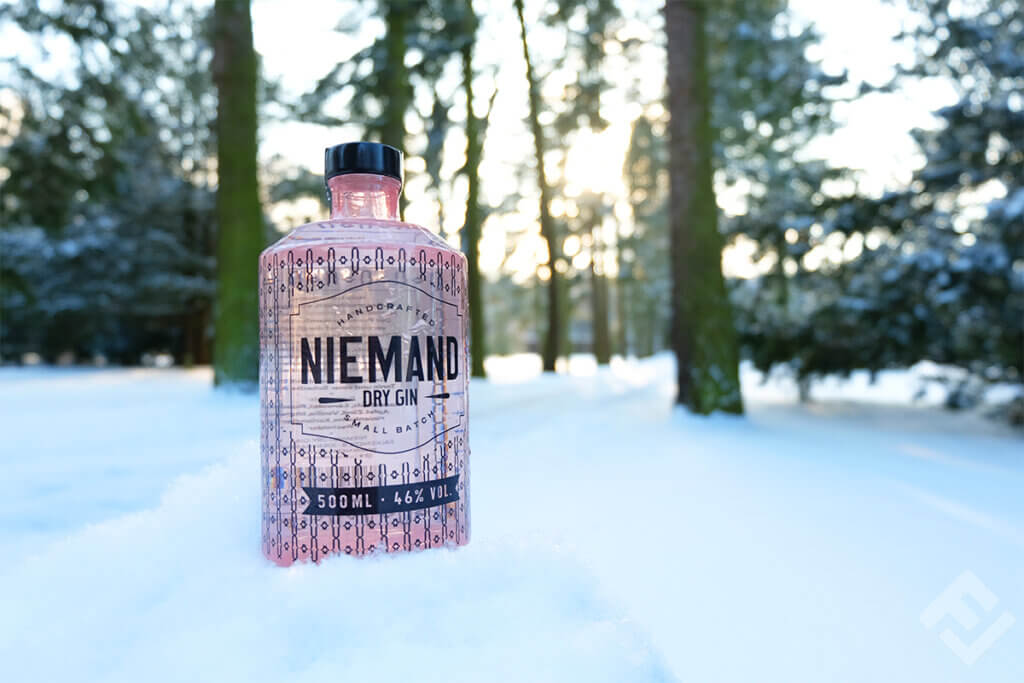
Pros
- Great range of flavours
- Well-balanced botanicals
- Full-bodied taste
- Goes well with different tonic waters
Cons
- None to mention
Rating
9.8 / 10
FinalCheck verdict
Niemand is a balanced gin that convinced us with its strong tart notes and a sweet aftertaste. It is not without reason that this German gin has already won several awards, with judges comparing it to a walk through a forest.
Niemand is like you
The story of Niemand began in 2008, when two friends opened a gallery for young art in Germany, excited about the fact that every artist is unique. Inspired, they set out to make a new gin. As a result, Niemand‘s slogan comes from this experience: “Niemand ist wie du” is German for “Nobody is like you”. Niemand gin has been on the market since 2015 and is enjoying growing popularity. Among connoisseurs, the gin from Hanover, Germany, is known beyond the country’s borders. The juniper berries-based drink is served in bars in Germany, but also in Austria, Great Britain, Switzerland, the Benelux countries, and even Hong Kong.

In recent years, the gin has received several awards. These include three silver and three gold medals.
Silver:
- Los Angeles International Spirits Competition 2017
- International Wine & Spirits Competition 2017
- New York Wine And Spirits Competition
Gold:
- China Wine & Spirits Awards 2017
- Singapore Spirit Awards 2018
- 2019 Japan Spirits Awards
According to Niemand, the flavour of the gin is less citrus, as you normally would expect, and instead more rosemary, sandalwood, and lavender. In addition, the flavour profile has hints of apple, ginger, cinnamon, coriander, vanilla, juniper, and pine nuts.
We were able to raise a glass with Niemand to give our taste buds a first impression. In the following review, we’ll reveal the real spirit of Niemand we found at our own very own tasting.
How do I taste gin?
With just a few steps, even newbies and gin beginners can start to compare drinks properly. First, pass a so-called nosing glass along your nose and open your mouth slightly when smelling. By following this procedure, you will be able to identify most of the aromas. Next, take a sip, but a small one. Once you get used to the gin, you can take larger sips. Now keep the gin in your mouth for a bit and let it reach all parts of it. The drink should glide over your tongue and the insides of your cheeks to allow all flavours to develop. Last but not least, swallow the gin, while paying attention to the sensation it leaves in your mouth.
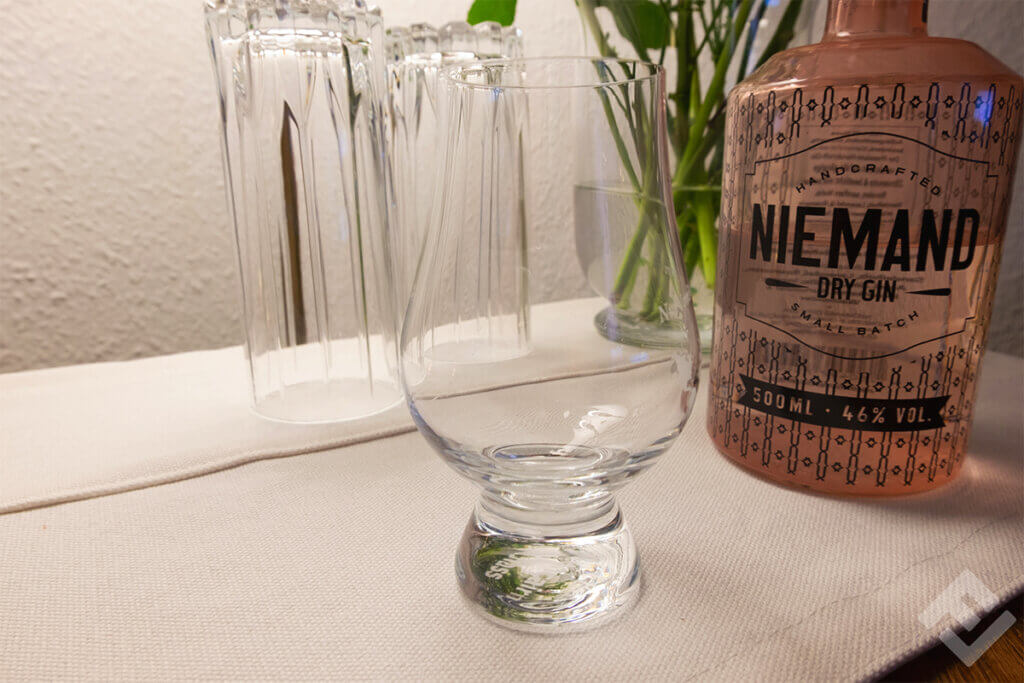
At a gin tasting, some parameters are already given from the nature of the spirit. After all, at heart, gin is made of juniper. This starting point is even recorded in its own spirits law to preserve the purity of the drink. The intensity of the juniper flavour as well as the other tasing notes of the gin are left to the distiller.
The taste of juniper is sometimes more, sometimes less pronounced. Juniper is characterised by a full-bodied aroma that can be described as woody, piney, or even citrusy. In addition, gin stands out with a light to strong bitter note. Classic gin has a particularly strong bitter note. To give their gin a distinctive taste, distilleries have the option to individualise their product by adding botanicals. The combination of different botanicals results in unique flavours. While some distilleries use just a handful of natural additions, others add dozens. Depending on the botanicals used, you tend to get five different resulting flavours:
- Citrusy
- Fruity
- Sweet
- Floral or flowery
- Spicy
Our test subject, Niemand, is a dry gin. This means that it must be distilled, using only natural or nature-identical spices and flavourings. Colorants are only permitted if they are nature-identical. Botanicals or plant extracts may be added at any point in the distilling process. The label “dry” does not necessarily mean that the taste is dry. “Dry” simply means that no further sweetening is added following distillation.
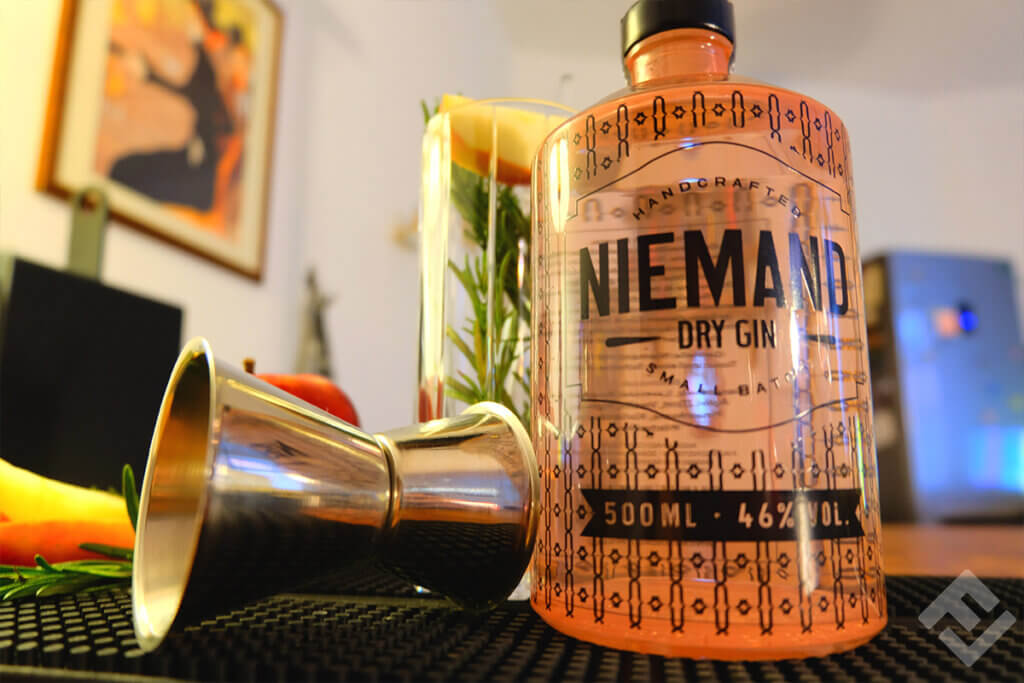
How we tested
When testing Niemand, we focused on the three main categories of tasting: appearance, smell, and taste. Since tastes are known to differ, we first focused on the distinctive flavour of Niemand and then evaluated the overall composition. Last but not least, we tested the gin in combination with tonic water and garnishes. We chose the garnishes based on a recommendation by the manufacturer.
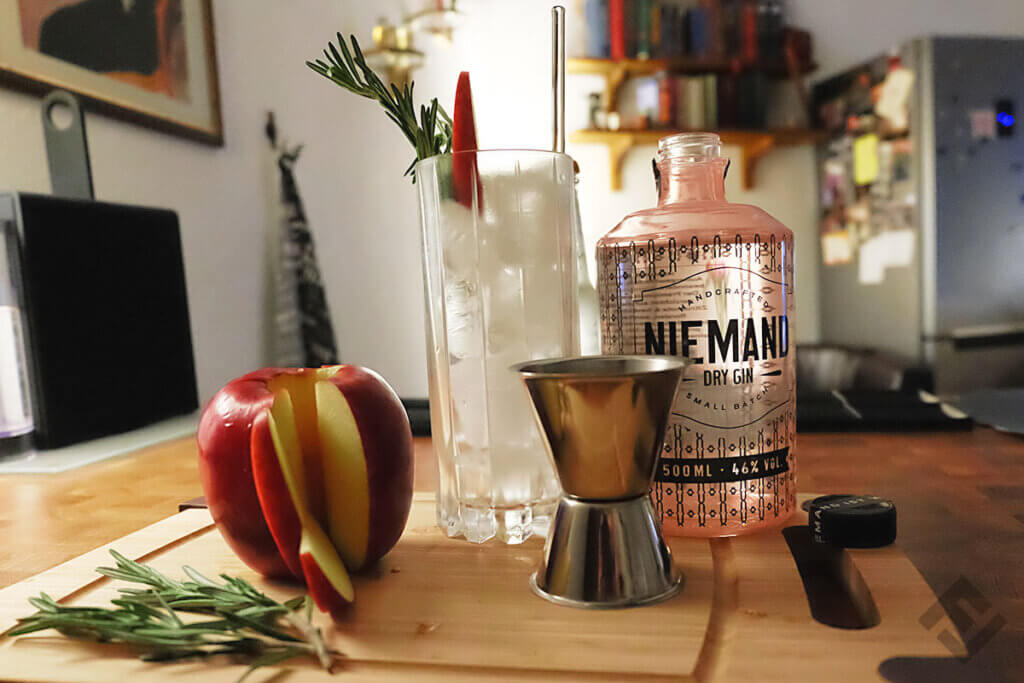
Appearance
Niemand‘s appearance is typical of a gin: it is clear. The transparent liquid has no sediment or suspended solids. When turning the glass, the drink moves slightly in a circle. Condensed water at the rim of the glass evaporates quickly and indicates freshness.
Smell
The smell of Niemand can probably best be compared to the scent of a coniferous forest in spring. This is mainly due to the added botanicals: rosemary, sandalwood, pine nuts, and lavender. Niemand‘s intense smell indicates a strong and natural character. On top of that, the gin has a fruity and fresh note that extends to slightly sweet: a hint of apple and ginger, as well as notes of vanilla and cinnamon are distinguishable, albeit not too overwhelming. In the end, there is also the gin-typical juniper note. This is also easily perceptible on the nose, but not dominant and gradually fades into the background. Most peculiarly, Niemand does without any citrus botanicals.
Taste
At the first moment, we realised that Niemand tastes different than it smells. The first taste is like biting into a pine cone — in a good way. Niemand fulfils its promise: with its natural notes of sandalwood and pine nuts, the gin flows through the mouth and evokes associations of a walk in the woods. But contrary to the smell, the sweetish flavours of the gin unfold far more strongly. Gradually, the lavender emerges too, mixing with the gentle aromas of vanilla as well as apple, giving the drink a concise sweet character. There is a pronounced fruity note in the aftertaste. Besides that, the ginger is clearly notable as a slight spiciness spreads across the tongue.

The combination makes the difference
Enjoying gin neat is rather unusual in bars and restaurants. After all, gin and tonic have always been inseparable. For our test, we mixed Niemand with three different tonics to bring out the individual notes from the gin.
What is tonic water?
Tonic water was considered a medicine to make quinine drinkable, which was used as a cure for malaria. In addition to quinine, the basic ingredients include sugar, lemon, and water. Depending on the recipe, other ingredients such as lemongrass or flowers are used. The overall bitter taste of tonic water goes very well with the bitter note of the juniper in gin. Herein lies the harmonised perfection of the two drinks.
Classic tonic water
In our test, we used a standard tonic water by Thomas Henry. It is already very bitter, which is why it passes this bitterness to the gin too. The gin and tonic tastes rather tart with a woody aftertaste. A second sip, however, reveals a slight vanilla note, so that the gin-tonic combination is very balanced overall. Niemand has a little of everything, but not too much of anything.
Elderflower tonic water
Next, we mixed Niemand with an elderflower tonic, also from Thomas Henry. The rather sweet tonic water makes the gin and tonic taste less bitter. A distinct floral note — dominated by lavender — gives the gin and tonic a fruity twist. The smoother taste can also be associated with the botanicals vanilla, cinnamon, and apple. This makes the gin and tonic taste like a sweet summer breeze reminiscent of a walk in the woods in summer, where the floral scents of flowering fields combine with the hearty notes of warm coniferous wood.

Dry Tonic
As a third variation, we chose Dry Tonic Water, a drier, less sweet tonic by Schweppes. The bitter taste of this tonic pushes the fruity notes of the gin into the background. The gin and tonic is thus more tart and very bitter — a bit too much for our taste — and the inherent flavour of Niemand is almost completely displaced.
Gin and tonic preparation
Pour the gin into a long-necked gin glass. Due to the shape of the glass, the flavours are not lost. Fill it completely with large ice cubes and pour in four to six centiliters of gin. You can then fill the glass with the chilled tonic of your choice. Last but not least comes the garnish.
Garnish
As a last step to our test, we added garnishes recommended by Niemand. Classically, gin and tonic is served with a slice of lemon. Since Niemand deliberately avoids citrus notes, a slice of lemon would feel off. Following the manufacturer’s recommendation, we opted for a piece of apple and a sprig of rosemary, as both are already used as botanicals in the gin. The garnish gives the gin and tonic a slightly fruity and natural note, optimally supporting the inherent taste of Niemand. This is exactly what a garnish is all about: emphasising the individual taste of a gin.

Assessment of the composition
At the end of our test, we assessed the composition of Niemand. The main focus was on the complexity, balance as well as the character of the gin.
Complexity
Niemand contains a total of ten botanicals. Thus, it is not the most complex gin when compared to other producers who add up to 50 different botanicals. However, less is sometimes more and, in this respect, Niemand completely convinced us. The Hanover distillery combines fruity and floral notes with “tart” flavours reminiscent of coniferous forests. The gin is aromatic that it evokes the feeling of a walk in the woods on a mild summer day.
Balance
The gin is overall very balanced. The individual notes alternate; starting with the differences that occur when smelling and tasting. The interaction of the two during drinking results in a unique composition. In combination with tonic water, the botanicals seem very balanced too. The natural woody flavour that sticks out at first, is followed by fruity notes that are accompanied by hints of vanilla and cinnamon.
Character
Niemand‘s character is particularly full-bodied and pronounced. The botanicals used fully emerge and come into effect in various stages. The gin is neither watery nor does it claim to have flavours that are not contained. The botanicals give it a natural character that doesn’t taste artificial in any way.
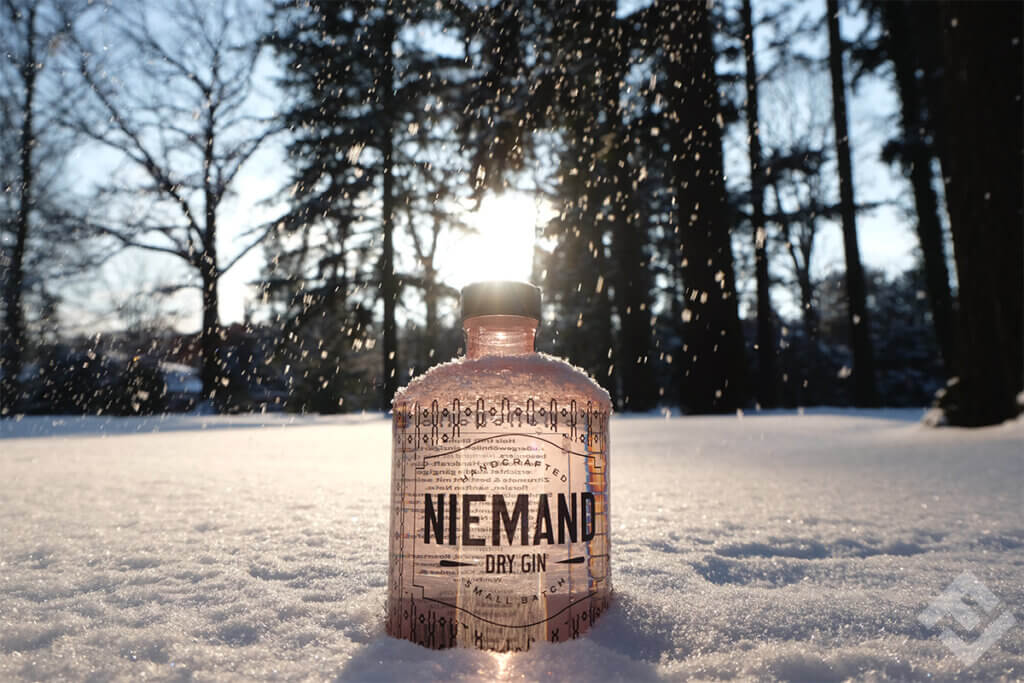
Summary
The bottom line is: Niemand is an excellent gin. The overall note of this spirit is something special and captivates with a mixture of sweet and fruity as well as savoury aromas. The botanicals complement each other very well and give the gin its balance. Niemand‘s character convinces sip after sip and unfolds its various notes more and more. What we particularly liked is the fact that Niemand can be mixed with different tonics. Both more bitter tonics, which complement the gin in this respect, as well as sweet tonics, which emphasise the fruity side of the gin, bring unique taste experiences: there is “Niemand” that goes better with tonic water than Niemand.
The German gin lives up to its promise: the spirit lets you to take a walk through a forest with just one sip. Like a delicate flower raising its head through the last snow of the year and announcing the beginning of spring, Niemand also bears witness to this blossoming of nature with its floral notes. In the right combination, it is equally capable of capturing the summery, lovely scent of seas of flowers amidst a forest. The association of nature and tart lightness go hand in hand with every sip of Niemand. In short, gin lovers should definitely keep Niemand in mind.
Imagen 1-8: © FinalCheck
